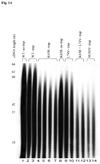Comparative analysis of in vitro processivity of HIV-1 reverse transcriptases containing mutations 65R, 74V, 184V and 65R+74V
- PMID: 19555722
- PMCID: PMC2769998
- DOI: 10.1016/j.antiviral.2009.06.002
Comparative analysis of in vitro processivity of HIV-1 reverse transcriptases containing mutations 65R, 74V, 184V and 65R+74V
Abstract
While HIV-1 reverse transcriptase (RT) mutations of M to V at position 184 are commonly observed in the clinic, the double mutation of 65R+74V is rarely seen. It has been demonstrated that rapid R-->K reversion occurs at RT codon 65 during replication of HIV-1 in human peripheral blood mononuclear cells containing 65R+74V mutations and that processivity of the RT is reduced relative to wild type. However, clinical studies show that M184V can be detected after several months of therapy interruption, suggesting more effective processivity. Herein, the in vitro RT processivity of genetically engineered M184V and double mutant 65R+74V was compared. Virion-associated RTs of WT pNL4-3, K65R, L74V, M184V and 65R+74V were used to perform RT processivity assays in the presence of trap, poly(rC)-oligo(dG). Both RTs with 184V and 65R+74V mutations exhibited similar processivity when compared with each other and a significantly decreased processivity as compared to WT RT. Both mutant RTs synthesized shorter cDNA molecules (37-42 nt) relative to WT RT, which made longer (65-70 nt) cDNA molecules. Since these surprising biochemical results cannot explain the clinical phenotype, a hypothesis is presented to explain the discrepancy and suggest new approaches for future testing.
Figures





Similar articles
-
A Leu to Ile but not Leu to Val change at HIV-1 reverse transcriptase codon 74 in the background of K65R mutation leads to an increased processivity of K65R+L74I enzyme and a replication competent virus.Virol J. 2011 Jan 21;8:33. doi: 10.1186/1743-422X-8-33. Virol J. 2011. PMID: 21255423 Free PMC article.
-
Replication-dependent 65R-->K reversion in human immunodeficiency virus type 1 reverse transcriptase double mutant K65R + L74V.Virology. 2004 Apr 10;321(2):222-34. doi: 10.1016/j.virol.2003.11.013. Virology. 2004. PMID: 15051383
-
Effects of the K65R and K65R/M184V reverse transcriptase mutations in subtype C HIV on enzyme function and drug resistance.Retrovirology. 2009 Feb 11;6:14. doi: 10.1186/1742-4690-6-14. Retrovirology. 2009. PMID: 19210791 Free PMC article.
-
The lysine 65 residue in HIV-1 reverse transcriptase function and in nucleoside analog drug resistance.Viruses. 2014 Oct 23;6(10):4080-94. doi: 10.3390/v6104080. Viruses. 2014. PMID: 25341667 Free PMC article. Review.
-
The impact of the M184V substitution on drug resistance and viral fitness.Expert Rev Anti Infect Ther. 2004 Feb;2(1):147-51. doi: 10.1586/14787210.2.1.147. Expert Rev Anti Infect Ther. 2004. PMID: 15482179 Review.
Cited by
-
L74V increases the reverse transcriptase content of HIV-1 virions with non-nucleoside reverse transcriptase drug-resistant mutations L100I+K103N and K101E+G190S, which results in increased fitness.J Gen Virol. 2013 Jul;94(Pt 7):1597-1607. doi: 10.1099/vir.0.050914-0. Epub 2013 Mar 27. J Gen Virol. 2013. PMID: 23535575 Free PMC article.
-
The high cost of fidelity.AIDS Res Hum Retroviruses. 2014 Jan;30(1):8-16. doi: 10.1089/AID.2013.0153. AIDS Res Hum Retroviruses. 2014. PMID: 24180375 Free PMC article. Review.
-
A Leu to Ile but not Leu to Val change at HIV-1 reverse transcriptase codon 74 in the background of K65R mutation leads to an increased processivity of K65R+L74I enzyme and a replication competent virus.Virol J. 2011 Jan 21;8:33. doi: 10.1186/1743-422X-8-33. Virol J. 2011. PMID: 21255423 Free PMC article.
-
Low prevalence of transmitted K65R and other tenofovir resistance mutations across different HIV-1 subtypes: implications for pre-exposure prophylaxis.J Int AIDS Soc. 2012 Oct 15;15(2):17701. doi: 10.7448/IAS.15.2.17701. J Int AIDS Soc. 2012. PMID: 23305651 Free PMC article.
-
Replication-independent expression of anti-apoptosis marker genes in human peripheral blood mononuclear cells infected with the wild-type HIV-1 and reverse transcriptase variants.Viral Immunol. 2012 Feb;25(1):12-20. doi: 10.1089/vim.2011.0057. Epub 2012 Jan 12. Viral Immunol. 2012. PMID: 22239233 Free PMC article.
References
-
- Arion D, Borkow G, Gu Z, Wainberg MA, Parnaik MA. The K65R mutation confers increased DNA polymerase processivity to HIV-1 reverse transcriptase. J. Biol. Chem. 1996;271:19860–19864. - PubMed
-
- Bakhanashvili M. p53 enhances the fidelity of DNA synthesis by human immunodeficiency virus type 1 reverse transcriptase. Oncogene. 2001;20:7635–7644. - PubMed
Publication types
MeSH terms
Substances
Grants and funding
LinkOut - more resources
Full Text Sources
Research Materials

